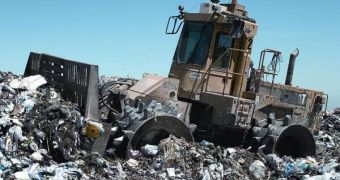A group of marine biologists and environmentalists from California is setting sail to the Northern Pacific this week, to visit the immense patch of garbage that has accumulated in the region due to converging currents. In the years since this formation has been made public, it has become obvious that the patch, now the size of a small island, is fueled from North America, Asia and Japan, and that it is made almost entirely out of plastic residues and other non-degrading materials. The new survey is destined to assess the evolution of the patch since the last time it was studied, Reuters informs.
According to the latest survey, the Great Pacific Garbage Patch is now stretching over hundreds of miles, and is made up of loose-bound pieces of trash, with a number of areas of higher density dotting this desolate landscape. The “island” is not solid enough to walk on, and anyone trying to do so can expect to sink amidst the debris and suffocate to death, the experts warn.
The new team setting out in the Pacific is based at the University of California in San Diego (UCSD) Scripps Institution of Oceanography. The scientists embarked on Sunday, and the whole crew is made up of about 30 members, including experts, technicians and sailors. Their expedition is expected to last for about three weeks, during which time they will collect samples, take pictures, and assess possible means of resolving the situation.
“The concern is what kind of impact those plastic bits are having on the small critters on the low end of the ocean food chain,” Scripps Director of Research Bob Knox explained on Monday, after spending the expedition's first full day at sea. Instances in which small birds have been discovered dead from plastic intoxication, after their parents fed them with junk, are becoming increasingly common. Fish contamination is also on the rise, as they consume phytoplankton that assimilated plastic inside. Humans eventually end up eating them and getting sick.
A host of other problems will be surveyed as well. Researchers want to determine whether the garbage can take small parasites, or other organisms into the deep sea, introducing new predatory species to local ecosystems and breaking their balance. Analyses will be conducted on the ship's onboard lab, but samples will be brought back for studies as well, the team says.

 14 DAY TRIAL //
14 DAY TRIAL //